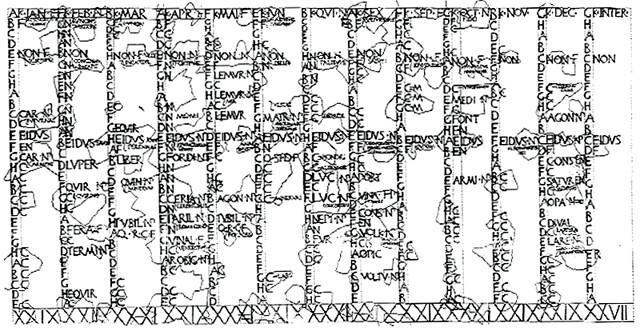
by John Copeland Monday, November 2, 2015

Pre-Julian Roman calendar found in the ruins of Nero's villa at Antium (Anzio). Credit: Public Domain.
As we approach the end of a year, my thoughts often turn to calendars and the measurement of time. Time is our window on the world; we use it to create order and shape our existence. We use time to measure grand things, like the rise and fall of civilizations, and small things, like the increments of our daily lives.
The tools we use to measure time are clocks and calendars. Clocks, at least when functioning, are always in the present, letting us know that time is passing at every moment. Calendars are linear, often made up of boxes signifying each day. When a day is over, its box is done, but it doesn’t disappear. I have always found calendars fascinating, because they show yesterday, today and tomorrow — past, present and future.
Calendars were founded on three observable astronomical cycles: The day, which is the time from one sunrise to the next — about 24 hours; the month, which is one complete orbit of the moon around Earth — approximately 29.53 days; and the year, which is one complete orbit of Earth around the sun — approximately 365.24 days.
The length of both the year and month are averages. The actual length of a year can vary from the average by several minutes because of the influence of gravity from the sun and the other planets in our solar system, which tugs on Earth and the moon and their respective orbits. Because of these constant changes, calendars have always been imperfect, and within a few years they can drift out of sync with the seasons. Ancient cultures had elaborate methods of re-syncing their calendars to the seasons, but they were cumbersome and complicated.
Julius Caesar changed that. In 47 B.C., the Roman calendar was a mess. It was 67 days ahead of the true time. Caesar used his authority as the emperor of the expansive Roman Empire to fix it.
Even though he was a student of astronomy, Caesar was hardly up to the task of revising the calendar himself. He called on a person who has pretty much been forgotten by history: an astronomer named Sosigenes. Almost no information is preserved about Sosigenes, except that he was a person of Greek descent living in Alexandria, Egypt — and that, for all his current anonymity, he came up with a calendar that is still the foundation of the one we use today, nearly two millennia later.
Sosigenes’ new calendar used the same named months as the old calendar had, but had 365 days (instead of 355 days alternating with 377 or 378 days), with an additional day added every fourth year to February. January, March, May, July, August, October and December had 31 days, while the intervening months each had 30 days with the exception of February, which had only 28 or, in leap years, 29.
But, before Sosigenes’ reformed calendar could be launched, the chronology of the year had to be brought back into sync with the seasons. Caesar decreed that the year 46 B.C. would have 445 days. Across the Roman Empire it was called the year of confusion. (I actually have years like that myself.)
The new calendar also rearranged the established order of the months. Instead of beginning in March, as the old Roman calendar had, Sosigenes began his on January 1. This is why the ninth month, September, derives its name from the number seven, October from eight, November from nine and December from ten.
And of course, Julius Caesar took all the credit for the reform; and the calendar even bears his name — the Julian Calendar.
The only real problem with the Julian Calendar was its handling of leap years. It gained about three days every four centuries. Thus, as the centuries passed, the Julian Calendar again became increasingly inaccurate with respect to the seasons. This was especially troubling to the Roman Catholic Church because it affected the determination of the date of Easter, which, by the 16th century, was almost slipping into summer.
Western nations measured time using the Julian Calendar until 1582, when Pope Gregory XIII authorized a correction to leap years that essentially fixed the calendar to make a closer approximation to the actual length of time it takes for Earth to complete one orbit around the sun. The resulting updated calendar was named for Pope Gregory and is the prevailing calendar system that we use today. This calendar still isn’t perfect, accruing an error of three days every 10,000 years, so eventually a correction will have to be made. The effort to measure and demarcate time, and to create a workable calendar, has been an incredible story of human ingenuity that continues to shape our world.
© 2008-2021. All rights reserved. Any copying, redistribution or retransmission of any of the contents of this service without the expressed written permission of the American Geosciences Institute is expressly prohibited. Click here for all copyright requests.